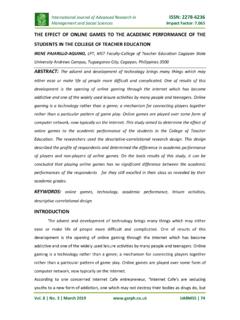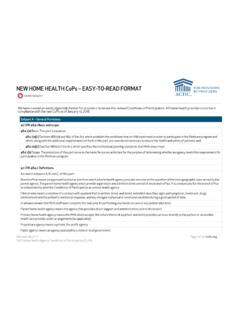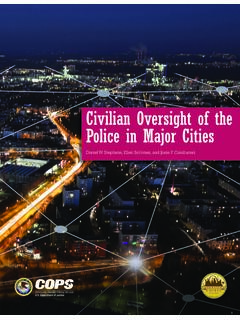Transcription of COMMUNITY CRIME PREVENTION: THE CASE OF A …
1 International Journal of Advanced Research in ISSN: 2278-6236 Management and Social Sciences Impact Factor: Vol. 9 | No. 6 | June 2020 IJARMSS | 98 COMMUNITY CRIME PREVENTION: THE CASE OF A BARANGAY IN THE NORTHERN PHILIPPINES By: Jezreel B. Vicente (Lead) Greg D. Ammiyao Phoebe Mae T. Arud Christopher P. Asiaben Nick R. Balunos Ulyssis D. Bangsara Anselmo B. Cacap Janette A. De vera Esther Joy P. Dela austria Cora M. Dogui-is Jeferson J. Fianitog Meriam D. Jagmis Wilson, Jr C. Lagan Maricel V. Leocadio Fairybelle K. Liwayan Vicenta Y. Mallari Vicente P. Nayosan Marish Leen M. Pagulayan Raymond G. Refuerzo Claire D. Rufino Graduate School, University of Baguio, Philippines ABSTRACT CRIME prevention is usually not the concern of everyone. CRIME prevention is a series of strategies done by the national government to the local government units to combat crimes. These strategies may include mobile or foot patrol, imposing curfew hours, information dissemination, and , the primary aim of CRIME prevention is to ensure the safety of the COMMUNITY .
2 This study focused on CRIME prevention of a barangay utilizing qualitative analysis. It determined the CRIME prevention activities that the Philippine National Police and barangay officials implemented and discovered the challenges encountered in the implementation of the CRIME prevention activities. The study involved 9 participants composed of 3 barangay officials, three residents of Barangay Lucnab and 3 Police Officers International Journal of Advanced Research in ISSN: 2278-6236 Management and Social Sciences Impact Factor: Vol. 9 | No. 6 | June 2020 IJARMSS | 99 from the Baguio City Police Station 3. All in Baguio City in the Philippines. The study was conducted from January 2020 until May 2020. In treating the data collected, the researcher made use of thematic analysis. Results showed that the Police Personnel and Barangay Officials are regularly conducting the following activities: regular patrolling (foot and mobile patrol), routine checkpoints, and CRIME prevention seminars.
3 It also showed that they had challenges in implementing these CRIME prevention programs such as having depleted personnel, inadequate CRIME prevention equipment, and instances of unreported cases KEYWORDS: CRIME prevention, challenges, implementation, police officers, barangay officials INTRODUCTION CRIME is one of the leading universal problems this day. From time to time, many lives and property were destroyed due to the criminal lawlessness committed. Society sees most crimes such as robbery, rape, murder, and assault as deviant and destructive to one's life and property. Those who want more and need more and powerful can simply take from the less powerful. CRIME has effects which are extensive as society itself. It can be as pervasive to development and debasing to the quality of life as personally dangerous, socially damaging, or politically embarrassing. It quiet erosion of national achievement and long term influence on motivation can be far more detrimental to a society that is currently permeates all aspects of society and, as such, is a form of warfare waged on a worldwide scale, with non-combatants on the losing side(UIA, 2019).
4 CRIME is a violation of rules of behavior as interpreted and expressed by the law, which reflects opinions, traditional values, and the viewpoint of people having social and political power. Individuals who go against these rules are subject to sanctions by state authority, social stigma, and loss of status (Siegel, 2008). CRIME is a destructive phenomenon, given the various effects that are evident in various literature. It ranges from physical disability, emotional crisis, psychological trauma, and International Journal of Advanced Research in ISSN: 2278-6236 Management and Social Sciences Impact Factor: Vol. 9 | No. 6 | June 2020 IJARMSS | 100 economic crisis to mention a few, law enforcement agencies are challenged to design and implement effective CRIME prevention activities. CRIME prevention refers to the various strategies that are devised and enforced by communities, businesses, non-government organizations and all levels of government to target the various social and environmental factors that increase the risk of CRIME , disorder and victimization (AIC, 2003; ECOSOC, 2002; IPC, 2008; Van Dijk & de Waard, 1991).
5 CRIME prevention activities vary from place to place in such that different places adapt to varied activities anchored in various theories of CRIME prevention. Understanding CRIME as a product of an environment naturally suggests that CRIME may be prevented and controlled. Paul Bartingan and Frederick Faust, as cited in Matsukawa and Tatsuki (1976), compared this idea to immunology and public health. Primary prevention aims to prevent the impact of disease or injury from occurring by maintaining a healthier population and avoiding unhealthy behavior. Secondary CRIME prevention aims to reduce the impact of a disease or injury by treating it as soon as possible, and tertiary CRIME prevention aims to soften the impact of an ongoing illness or injury through rehabilitation and livelihood support. Primary CRIME prevention aims to prevent CRIME from occurring by creating and maintaining safe environments from a criminology perspective.
6 Secondary CRIME prevention aims to address incivilities and deviances before they lead to criminal activities, and tertiary CRIME prevention seeks to rehabilitate offenders through punishments, corrections, probation, parole, and COMMUNITY support. One approach to CRIME prevention was based on the concept of the CRIME prevention triangle: desire, ability, and opportunity. According to Hallock (2001), as cited in Gubatan (2011), taking away any of the three elements of the CRIME triangle, prevents the occurrence of CRIME . He further suggested that opportunity is the most natural component to control, which can break the CRIME prevention triangle to win the battle against CRIME . Under United Nations standards and norms on CRIME prevention, UNODC contributes to CRIME prevention and control for international and national efforts. UNODC assists member states in enhancing the ability of primary CRIME prevention actors and systems to be more productive with particular attention to weaker groups.
7 UNODC also focuses on creating International Journal of Advanced Research in ISSN: 2278-6236 Management and Social Sciences Impact Factor: Vol. 9 | No. 6 | June 2020 IJARMSS | 101 specialized tools and manuals in support of policymaking and the delivery of technical assistance. Addressing the UN Security Council, The United Nations Secretary-General observed that in matters of justice, prevention is worth better than a cure. Prevention is the first imperative of justice o, the prevention of CRIME is the keystone requirement for the establishment of a safe and secure society, the achievement of which is a prerequisite for healthy economic growth through continuing business investment as well as COMMUNITY wellbeing cohesion (Homel, 2009). In the Philippines, Republic Act 6975 or the "Department of Interior and Local Government (DILG ) Act of 1990", as amended directs the National Police Commission to recommend to the President, through the Secretary of the DILG a national CRIME prevention program.
8 The NAPOLCOM developed the 2019 National CRIME Prevention Program (NCPP) through its Technical Committee on CRIME Prevention and Criminal Justice, an ad-hoc interdisciplinary body composed of acknowledged experts from government agencies and non-government agencies involved in the criminal justice system. To ensure the success of the NCPP, the office of the President issued Memorandum Circular Order No. 66, which directs all government agencies and local government units to support the same. The 11th United Nations (UN) Congress on CRIME Prevention and Criminal Justice in 2005 provides an account of the development of the COMMUNITY Oriented Policing System (COPS) adopted in the Philippines in 1994. It is a part of the national anti- CRIME strategy, which is now included in the National CRIME Prevention Program adopted in 2004.
9 Accordingly, the COPS program is 'people-powered' and utilizes the first projects to explain its pros. In 1986, the first initiative BAC-UP was developed in Bacolod City modeled on the Japanese 'Koban' system. It displayed decentralized COMMUNITY -based police stations at the local level. The project developed solid police- COMMUNITY links at the local level, which has continued to grow and been sustained over 18 years. The COPS system is built on the same principles of utmost integrity, trust, participation, and civic-mindedness of both officials and citizens (Braga & Weisburd, 2001). International Journal of Advanced Research in ISSN: 2278-6236 Management and Social Sciences Impact Factor: Vol. 9 | No. 6 | June 2020 IJARMSS | 102 The Philippine National Police said CRIME prevention remains a top priority to ensure public security and safety but needs the COMMUNITY 's active support and cooperation.
10 Cooperation stakeholders are the primary key and should be done to maintain safety in the COMMUNITY . Citizens are encouraged to report and become volunteers by informing the PNP about suspicious movement of persons such as modus operandi in their area.(Patoza, 2018) In the local setting, Quilang (2017) claims that the type of living conditions and social environment in Baguio City accompanied by urbanization has also affected CRIME trends. For instance, in urban areas, a CRIME such as theft, robbery, violent CRIME , and drug-related CRIME has drastically increased. Simultaneously, the type of offenses executed by organized criminals, juveniles, and foreigners become more grave. This event generates "feelings of insecurity" in many people, especially those living in urban areas. This increase in CRIME has adversely affected the "quality of life" in the COMMUNITY and poses a serious cause of hindrance to the sustainable growth of a country Recently, however, according to reports released by the Baguio City Police Office, the CRIME rate in Baguio City continuous to decrease.





